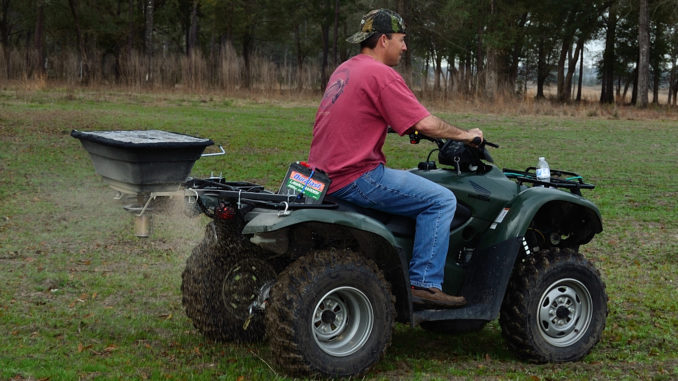
Prevent overbrowsing before it happens
The planting season for spring and carryover food plots begins as early as March and will continue through the end of May. For the past five months, landowners and wildlife managers have been busy collecting soil samples, distributing lime, turning dirt, scattering fertilizer and then embedding seeds just below a shallow soil blanket. The next four to six weeks is an extremely critical period for food plots. Through a variety of physical and chemical means, wildlife managers must be prepared to ward off animals that would destroy them.
Intense planning and carefully-calculated soil adjustments bring the land manager a little closer to that food-plot masterpiece. While some crops lack immediate forage affection after emergence, many spring plantings attract wildlife as soon as the tender sprouts become visible. In some cases, deer and other wildlife are so deprived of natural foods, they will dig up the seeds before they ever germinate.
If allowed to develop into a mature or semi-mature plant, most forage food-plot varieties can withstand repeated browsing as they are intended. But the first four to six weeks after emergence is the critical development period, and vigilance is required during this stage to receive the anticipated effects of a beautiful, nutrient-packed wildlife oasis.
While some birds and small mammals will work over young plots, deer and hogs are the real crop killers. In order for these crops to survive, deterrents must exhibit a valid threat to the deer and other crop destroying culprits. Basically, the two main crop-protection devices come in a physical or chemical form. Since deer and hogs are the biggest threat, fences and apparent impenetrable barriers will stop these animals from invading the plots. Wire and fencing are the most common types of physical barriers. Deer have been documented to jump over 12-foot obstacles when pressured. High fences will physically-prevent any animals from jumping into the plots, but their material and erection costs are very high and counterproductive.
Luckily, deer will generally stay out of food plots with an electric fence installed around the perimeter. The fence really does not need to be very high to be an effective deterrent. If natural foods are available in the vicinity of the food plot, and deer densities are not too high, deer will steer around the fenced-in area long enough for the crops to flourish. When pressure is low, the fence does not need to be any more than three feet high, with at least two strands of electrically-charged wire.
As an additional measure, deer can be lured towards the fence to get a taste of the electric current. Corn or some other attractant can be placed under or on the hot wire itself. The deer will feel the electric current immediately, learning to stay away from the area where this wire surrounds. The wire should be well marked with colored or white flagging tape or some other recognizable marker around the perimeter of the plot. Deer will quickly learn to stay away from this area while this fence is around. Fencing is one of the most effective ways to keep deer and other pests out of newly-planted plots, but this method is among the most expensive and labor intensive method available.
Chemical deterrents are probably the most common defensive tactic, with the least amount of work involved to apply and maintain. Commercially, chemical deer repellents come in granular and liquid forms. These types of repellents are intended to frighten deer, repel or cause distaste when consumed. The liquid forms are usually sprayed on plants themselves or dispensed on an absorbent tape draped around the perimeter of the food plots. Coyote urine and the ingredients in Plot Saver will deter deer, to a degree, from entering the plot. Other chemicals such as capsaicin, the active ingredient in hot peppers, will deter deer from consuming these plants when eaten.
Chemical deterrents in granular or solid forms are also readily-used with good effectiveness in some areas. Milorganite is a low-nitrogen fertilizer made from dried human feces and is a low-cost method for deterring deer from destroying food plots. Milorganite is either spread around the perimeter or all over the plot at a rate of approximately 100 pounds per acre. Deer living in the wild prefer to stay away from areas where human scent is widespread. Milorganite should be applied shortly after planting and must be every four to six weeks or re-applied after a heavy rain event.
Other homemade chemical and physical solutions can be effective, too, including mixtures of human hair, fragrant soap mixtures, and wind-blown noisemakers. But wildlife managers will have some degree of depredation under almost any physical or chemical means. However, food plots must be allowed to develop with little foraging during the first four to six weeks of life.




Be the first to comment